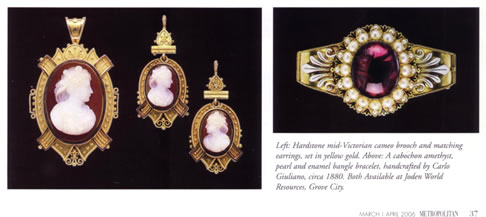|
|||
“Objects of Adornment”by Susan Larkin
Anthropologists have long cited man’s ability to make tools as the distinguishing characteristic that separates him from all other animals. Not so, we have learned – other creatures make tools. What really makes us human? We like to decorate – especially ourselves – for no other purpose than beauty. |
|||
Making objects for personal adornment dates back well into pre-history and we seem to favor things that sparkle and shine. Once soft malleable metals like copper, silver, and gold were discovered, and precious stones like diamonds, rubies, and emeralds and not-so-precious agates, coral, malachite and others caught our eye, man has been creating objects that serve only to adorn. Ancient fine jewelry, using precious metals and stones were the perquisites of nobility. Many beautiful objects still exist in museums, where we can admire the skill and aesthetic sense these ancient jewelers practiced. The Victorian Era (1837-1900) flourished during the time Queen Victoria of England ruled. The Queen set much of the fashion trends of this period. Jewelry of this era is divided into early (1837-60), mid or Grand (1860-85), and late or Aesthetic (1885-1900). Examples of the mid and late Victorian period are more readily available as the number of people who could afford jewelry was much greater as the Industrial Revolution gave rise to a large monied class.
|
 |
||
|
Although diamonds had been worn for centuries from Roman times to the Renaissance, it was the discovery of large deposits in South Africa in 1867 that let to the great emergence of diamonds in the late 19th century jewelry design. The Edwardian Period (1901-1910) was named after Queen Victoria’s son Edward VII, who succeeded her in 1901. This briefest of periods is characterized by the use of platinum and diamonds to create lovely, lacy and very feminine designs in pins, rings, bracelets and necklaces. Advances in technology born out of the industrial revolution allowed jewelers to work in platinum. Platinum (sometimes used over gold) encased diamonds, pearls, and moonstones, creating bright eye-catching pieces and were favored for their white-on-white color scheme that evoked a sense of refined elegance and luxury. Think, Titanic, and the newly formed DeBeers cartel. Art Nouveau (1890-1919) translated as ‘new art’ is a style, that gained worldwide prominence in the Paris Exhibition of 1900. Jewelry that was created during the Art Nouveau period embodied art for the sake of art, as well as a dramatic trend in fashion. This motivated designers to use enameling techniques. Think ‘swirl’ and you are thinking ‘Nouveau’. Inspired by nature, flowing shapes and lines created curvaceous designs that graced the era. The feminine form was highly celebrated and nature motifs were highly stylized into accessories that were accented with color gemstones cut in cabochons – a convex form that is highly polished, but not faceted. Gemstones that were used include amber, opals, moonstones, citrines, and peridots, along with other interesting materials like horn, copper, tortoise-shell, ivory, carved glass, shells, and pearls. Think the designs of Rene LaLique and Louis Comfort Tiffany, two of the world’s finest designers of Art Nouveau objects. Art Deco (1920-1935) was a counterpoint to the Bell Epoque ear of Art Nouveau and was the era of Jazz and flappers. Instead of the free flowing swirls and shapes of Nouveau, Art Deco is all about straight lines and geometry – the influences of cubism is apparent. Strong geometrical patterns and angular shapes were set with gemstones that were also cut into unusual shapes like baguette, emerald, and triangle, complimenting the flamboyant and playful attitude of the day. Rather than the swirling, bright combinations that dominated Art Nouveau, Art Deco pieces have dramatic contrasting colors – the reds of rubies and white of diamonds, onyx and diamonds, diamonds and sapphires – all combinations that accented the streamlined designs. Think the Chrysler building in New York City. The why and how of collecting antique jewelry consist of the obvious and the not so obvious. The ‘not so obvious’ is the value of these pieces. Most of the jewelry made between the 1830’s and the 1920’s were one-of-a-kind pieces. Jewelers were people who actually made jewelry, and learned their trade as ‘bench man’ – whose responsibility it was to turn a drawing or idea from a client and create a piece of jewelry, it was a custom affair – you went to your local jewelry store and it was made. “To have a piece of jewelry made today is very expensive, and very few jewelers do it,” say Joseph Murawski, owner of Joden World Resources in Grove City, one of the largest purveyors of antique jewelry in the country. “The value in these antique pieces is significant – a piece of fine antique jewelry costs 35 to 50% less than a comparable modern one,” Murawski explains. When you purchase a antique jewelry, you are also buying a piece of history. Great beauty, great value, one-of-a-kind – so now you are tempted- what to do and where to go? All experts agree – buy what you love. It may be an era that calls to you, or particular pieces of different design periods speak to you. Deep pockets are not a prerequisite to acquiring antiqued jewelry. While it is true that spectacular, museum quality pieces running into the hundreds of thousands of dollars are available, fine pieces exist in the more affordable range of $200 to the low thousands. These more modest sums make it possible to own a signature piece of wearable history. If you are a beginning collector, the best way to obtain these pieces is from reputable jewelry and antique stores. Although pieces are available at auctions, those sources are not for the beginner. Most auction items are sold ‘as is, where is, without guarantee or warranty’. Auction purchases require significant knowledge to avoid making serious mistakes. Jewelry stores, on the otherhand, often warrant their merchandise. Ask the store what their policies are. Do they offer a return policy, and for how long after you buy the piece? Do they guarantee the IS what they say it is – diamonds in platinum, no glass in silver, for example? Get any history of the piece that the store may have, such as who may have owned or made it. Collecting antique jewelry is a wonderful way to acquire pieces you will enjoy for a lifetime. Adorning yourself with pieces of antique jewelry is sure to elicit compliments from all who see them. Happy hunting!
|
|||



